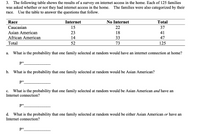
MATLAB: An Introduction with Applications
6th Edition
ISBN: 9781119256830
Author: Amos Gilat
Publisher: John Wiley & Sons Inc
expand_more
expand_more
format_list_bulleted
Concept explainers
Topic Video
Question

Transcribed Image Text:3. The following table shows the results of a survey on internet access in the home. Each of 125 families
was asked whether or not they had internet access in the home. The families were also categorized by their
race. Use the table to answer the questions that follow.
Race
Internet
No Internet
Total
Caucasian
15
22
37
Asian American
23
18
41
African American
14
33
47
Total
52
73
125
What is the probability that one family selected at random would have an internet connection at home?
а.
b. What is the probability that one family selected at random would be Asian American?
c. What is the probability that one family selected at random would be Asian American and have an
Internet connection?
p=.
d. What is the probability that one family selected at random would be either Asian American or have an
Internet connection?
Expert Solution
This question has been solved!
Explore an expertly crafted, step-by-step solution for a thorough understanding of key concepts.
This is a popular solution
Trending nowThis is a popular solution!
Step by stepSolved in 4 steps

Knowledge Booster
Learn more about
Need a deep-dive on the concept behind this application? Look no further. Learn more about this topic, statistics and related others by exploring similar questions and additional content below.Similar questions
- United Airlines' flights from Denver to Dallas are on time 90 % of the time. Suppose 5 flights are randomly selected, and the number of on-time flights is recorded.Round answers to 4 decimal places.a. The probability that exactly 3 flights are on time is .b. The probability that at most 4 flights are on time is .c. The probability that at least 4 flights are on time is .arrow_forwardAnswer parts A, B, and C based on the following scenario. A jar has 20 marbles: 5 green, 7 blue, 8 red. A. What is the probability of randomly choosing a red marble? Answer with a simplified fraction or a percentage rounded to the nearest whole number. B. What is the probability of randomly choosing a red or a green marble? Answer with a simplified fraction or a percentage rounded to the nearest whole number. C. What is the probability of randomly choosing a red and then a green marble (keep the red marble when you choose it)? Answer with a simplified fraction or a percentage rounded to the nearest tenth.arrow_forwardplease show work on a piece of paperarrow_forward
- As part of a statistics project, a teacher brings a bag of marbles containing 700 white marbles and 300 red marbles. She asks her students to determine how many red marbles are in the bag without counting them.A student randomly draws 100 marbles from the bag. Of the 100 marbles, 33 are red.The target population consists of The 100 marbles drawn by the student The 1000 marbles in the bag None of the above The 33 red marbles drawn by the student The 300 red marbles in the bag The sample consists of The 1000 marbles in the bag The 100 marbles drawn by the student The 33 red marbles drawn by the student None of the above The 300 red marbles in the bag Based on the sample, the student would estimate that ------ marbles in the bag were red.arrow_forwardA sports franchise knows that 81% of their season ticket holders attend every home game. The collect a random sample of size 250 from among last year's season ticket holders. How likely are they to find that 200 or fewer attended every home game? a. .657 b. .800 c. .343 d. .500arrow_forwardAnswer.arrow_forward
arrow_back_ios
arrow_forward_ios
Recommended textbooks for you
 MATLAB: An Introduction with ApplicationsStatisticsISBN:9781119256830Author:Amos GilatPublisher:John Wiley & Sons Inc
MATLAB: An Introduction with ApplicationsStatisticsISBN:9781119256830Author:Amos GilatPublisher:John Wiley & Sons Inc Probability and Statistics for Engineering and th...StatisticsISBN:9781305251809Author:Jay L. DevorePublisher:Cengage Learning
Probability and Statistics for Engineering and th...StatisticsISBN:9781305251809Author:Jay L. DevorePublisher:Cengage Learning Statistics for The Behavioral Sciences (MindTap C...StatisticsISBN:9781305504912Author:Frederick J Gravetter, Larry B. WallnauPublisher:Cengage Learning
Statistics for The Behavioral Sciences (MindTap C...StatisticsISBN:9781305504912Author:Frederick J Gravetter, Larry B. WallnauPublisher:Cengage Learning Elementary Statistics: Picturing the World (7th E...StatisticsISBN:9780134683416Author:Ron Larson, Betsy FarberPublisher:PEARSON
Elementary Statistics: Picturing the World (7th E...StatisticsISBN:9780134683416Author:Ron Larson, Betsy FarberPublisher:PEARSON The Basic Practice of StatisticsStatisticsISBN:9781319042578Author:David S. Moore, William I. Notz, Michael A. FlignerPublisher:W. H. Freeman
The Basic Practice of StatisticsStatisticsISBN:9781319042578Author:David S. Moore, William I. Notz, Michael A. FlignerPublisher:W. H. Freeman Introduction to the Practice of StatisticsStatisticsISBN:9781319013387Author:David S. Moore, George P. McCabe, Bruce A. CraigPublisher:W. H. Freeman
Introduction to the Practice of StatisticsStatisticsISBN:9781319013387Author:David S. Moore, George P. McCabe, Bruce A. CraigPublisher:W. H. Freeman

MATLAB: An Introduction with Applications
Statistics
ISBN:9781119256830
Author:Amos Gilat
Publisher:John Wiley & Sons Inc

Probability and Statistics for Engineering and th...
Statistics
ISBN:9781305251809
Author:Jay L. Devore
Publisher:Cengage Learning

Statistics for The Behavioral Sciences (MindTap C...
Statistics
ISBN:9781305504912
Author:Frederick J Gravetter, Larry B. Wallnau
Publisher:Cengage Learning

Elementary Statistics: Picturing the World (7th E...
Statistics
ISBN:9780134683416
Author:Ron Larson, Betsy Farber
Publisher:PEARSON

The Basic Practice of Statistics
Statistics
ISBN:9781319042578
Author:David S. Moore, William I. Notz, Michael A. Fligner
Publisher:W. H. Freeman

Introduction to the Practice of Statistics
Statistics
ISBN:9781319013387
Author:David S. Moore, George P. McCabe, Bruce A. Craig
Publisher:W. H. Freeman